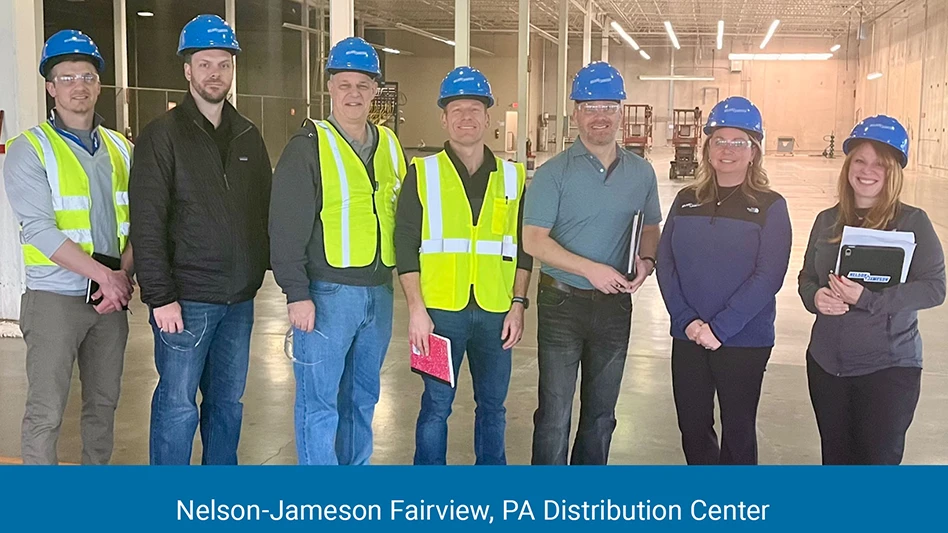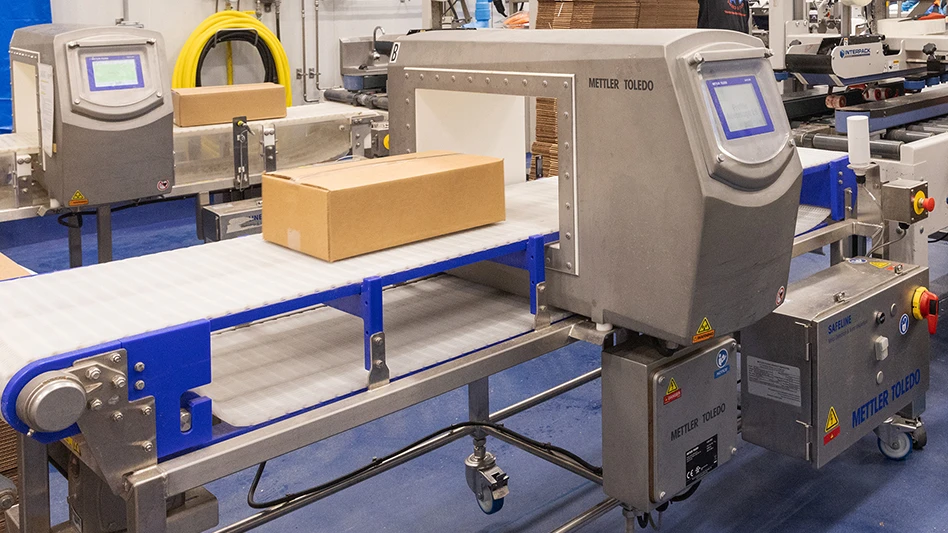When placing equipment on your line for foreign object control, the real goal should not be detection, but prevention of the cause, said Robert Rogers, Mettler Toledo senior advisor for food safety regulation. “I don’t look at it as a contamination notification device, but as a contamination prevention device,” he said. The device should be part of a continuous improvement program, so that “at some point, there should be no activity on the detector.”
John Klinge, Eriez product manager for metal detection, expresses similar sentiments when he trains on the use of metal detectors. “They are used to inspect and protect,” he said. As the devices inspect product for contamination, they are protecting the product, the equipment and the consumer from harm.
Devices placed at the front end of production challenge a processor’s suppliers, he said. “It forces them to clean up their act. We’re pushing the ownership of it earlier in the process.” But end-line devices are just as important, not only from inadvertent in-plant contamination but from that which is deliberate as well. “We hate to say this and we hate to think about it, but there is sabotage out there,” Klinge said.
In the same vein of prevention, Rogers doesn’t feel plants should test their equipment—rather they should “challenge” it. “Challenge it to detect the smallest speck in the most difficult area.” Too many plants simply run a test strip through the metal detector once, then pick it up before challenging the rejection unit. Instead, he said, place a particle in different parts of the product and run it through different places on the belt. Then leave it in place to make sure it is pushed into the rejection bin—and that the bin is not too full to accept it.
“It’s not just having that piece of equipment there, it’s having it a part of your program, he added. “You really don’t set up a system to see a speck with metal detection or x-ray, you set it up to successfully run production.”
Detection Devices.
Because metal detectors utilize electromagnetic fields, they are susceptible to outside interference, particularly in areas with a lot of equipment and electrical voltage. “Those sorts of environments can create havoc on a detector that is set up to receive those sorts of signals,” Rogers said. The concern, however, is not that it is picking up the signals, but that an environment be created to stop the interference—with the goal of always running the detector on maximum sensitivity without false positives.
The worst thing a plant can have is false rejects, he said. When there is a high level of rejects and with no contamination found, then rejection becomes the norm, confidence in the equipment goes down and workers end up turning off the device, Rogers said.
“That’s a horrible process,” he said. “When a speck comes through—or a hammer or a screw—nothing happens.” So instead, the equipment should very rarely react, so that when it occurs, there is some level of escalation.
To ensure that every piece of metal in the plant will be recognized, added Tom Ambrosia, TUV SUD America food safety program manager/lead auditor, the sensitivity of the metal detectors should be adjusted to the smallest piece of metal that could pass through it. This requires employee training, he said, noting that employees who are not fully trained and don’t understand the machines can be a big issue. “Many employees will overstep the settings so they are not bothered by ‘false positives’ or rejected items,” he explained.
Innovation.
While the general process of metal detectors is virtually unchanged in recent years, innovation has involved power, speed, convenience and conveyance.
A recent advance is the rotating grate magnet, used primarily with fine-powder products. The equipment incorporates standard magnetized grates to pull out metal contaminants, but its rotating device provides sifting action to keep fine powder from bridging over or building up on the grates. This can be of great benefit, particularly in plants Klinge has seen where an employee spends his entire day banging on the side of the tube and housing to make the material flow through the grates.
“The biggest innovation I see—and I see it going much further,” Ambrosia said, “is the marriage of metal detection and x-ray, and where the computer software learns each time it senses a rejection due to size or unknown material.
Because metal detectors and x-ray each have benefits and deficits, Ambrosia sees them as best used in combination. “Metal detection only does metal, whereas x-ray is going to be better and, I think, more useful—but only as a combination or add-on.”
Before buying a machine, Ambrosia recommends that a plant representative see it in operation. It can also be advantageous to lease with an option to buy. “These machines do change, just like a computer,” he said. “When you can lease, you can save money and are sometimes able to acquire two machines for the price of one.”
Detect-ability.
Another area of continued innovation in detection is that of integrating detectable material in tools commonly used in the processing area, such as utensils, pens, lanyards, gloves, etc. This includes the fusing of metals into plastics for detection by metal detectors, but new technology has also created additives that increase x-ray detection as well.
However, it is critical that plants carefully check items and plastics they are using in the processing area to ensure they are safe for food use—particularly in relation to plastics. While many products can be purchased from foreign countries, such as China, said Detectapro President Jim Elliott, processors need to take care as there can be a great deal of recycled plastic used—including materials not authorized for food contact.
Visual Detection.
A detection technology that is continuing to gain ground in food processing for both its protective and quality aspects is the vision system. It is similar to x-ray except that vision technology focuses on the exterior of a product or package rather than the interior, said Scott Stone, Mettler-Toledo CI-Vision marketing manager. “It looks for anything outside the range of specifications. It looks for anomalies outside that good image.” Visually comparing each product or container on the line against the good image, vision rejects anything that is not an exact match, he explained.
The technology began in the 60s, was used in the 70s to read codes such as OCR/OCB, was improved in the 80s but its high cost kept it out of reach for many, then in the 90s finally became a more economically viable option for processors.
The system is often used for quality checks such as label inspection and fill level, Stone said, but it is also beneficial for safety checks such as detecting contaminants inside bottles prior to fill, or finding glass chips, swarf or shavings from molded plastic, and for contaminants such as insects and bone which neither metal detectors nor x-ray can pick up.
Regulation and Standards.
Although there are no specific FDA or USDA regulations on the use of detection equipment, any contaminant greater then seven millimeters is considered to be an adulterant, Ambrosia said. A metal detector, x-ray or combination machine is usually placed before expensive equipment to avoid damage and at the end of packaging before the item is placed into the outer carton. However, he added, “Where they are placed is based on the company experience and is not controlled at this point by any regulatory agency that we are aware of.”
Instead, Elliott said, standards for such devices are being driven by retailers rather than regulation or even HACCP, for which the detectors are often CCPs but are not mandated. And it is often the consumer who is driving the retailer. Or, as Elliott noted, “the obnoxious consumer”—though justifiably so when having found a contaminant in a jar or box of food. “When you go back to the grocery you’re typically not a happy camper,” he said. So when the retailer has to go back to a supplier, it is that much more likely to initiate steps to ensure it doesn’t happen again.
Elliott foresees such prevention as continuing to grow within the United States and globally. “I think standards will definitely come about. They are working now on committees internationally,” he said. “Four or five years down the road, there will be implemented standards and guides for people to work by, and it will be mandated.”
But, he added, it also comes down to cost. “If it’s not realistic, you can’t do it.”
The price of a recall for one piece of glass can more than pay for an x-ray machine, Klinge said, and detecting one piece of metal prior to an expensive machine will yield a faster return on the investment. On the other hand, he added, “One lawsuit can bring a company down.”
Today into Tomorrow.
“I think that, as time moves on,” Klinge said, “foreign object detection will only increase—as companies have harder standards to follow and are looking out for the consumer.”
“I think the food we produce today is as safe as ever,” Rogers said. “I think that science is just catching up.” Today we can detect more, can fingerprint different strains, and have greater tracking and tracing capabilities, he explained. “Product recalls can be more specific rather than a store having to clear its shelves of everything.”
Because there is and will be accidents that happen and disgruntled workers who seek to settle a score, “it’s really not safe to say you can prevent adulteration,” Elliott said. But, he added, “I think all are using diligent efforts and doing a good job.”
It is all is based on continuous improvement, Klinge added. “Today’s technology is not good enough for tomorrow. Tomorrow’s is not good enough for the next day.”
Whether you use metal detection, x-ray, vision technology or a combination of the three, incorporating such systems into your process is a proof of diligence in the event of a recall, consumer complaint or inspection. Because every item goes through the device, Stone said, the processor can say, “We’ve inspected 100 percent of our product. We’ve done the best that we can do.”
The author is Managing Editor of QA magazine. She can be reached at llupo@giemedia.com.
Get curated news on YOUR industry.
Enter your email to receive our newsletters.

Explore the December 2010 Issue
Check out more from this issue and find your next story to read.
Latest from Quality Assurance & Food Safety
- USDA Announces New Presidential Appointments
- FDA to Phase Out Petroleum-Based Synthetic Dyes in Food
- IFT DC Section to Host Food Policy Event Featuring FDA, USDA Leaders
- CSQ Invites Public Comments on Improved Cannabis Safety, Quality Standards
- Registration Open for IAFNS’ Fifth Annual Summer Science Symposium
- Leaked White House Budget Draft Proposes Shifting Inspection Responsibilities from FDA to States
- Chlorine Dioxide: Reset the Pathogenic Environment
- Ferrero Group Invests $445 Million in Ontario Production Facility






